Late Georgian Mahogany Bureau – Circa 1770
__________________________________________________________
 Flanagans
is a partner of Furniture-HQ, with whom we cooperate to deliver to the
Chinese market unique pieces of Western Antiques, straight from their
workshops in Ireland to our Beijing wholesale warehouse. You can read more
about them here: Irish
Antiques in Beijing.
Flanagans
is a partner of Furniture-HQ, with whom we cooperate to deliver to the
Chinese market unique pieces of Western Antiques, straight from their
workshops in Ireland to our Beijing wholesale warehouse. You can read more
about them here: Irish
Antiques in Beijing.
_________________________________________________________
Dimensions:
110cm Long x 60cm Deep x 105cm High
Writing Surface Height – 76cm
The provenance of this bureau is most likely Scottish / Irish. The leg on
this is Georgian Irish. It is most unusual. It is beautifully proportioned.
This mahogany bureau/desk is of a generous, useful size. It
has a number of unusual features, some of which I found but not together on
any bureau illustrated on the Internet. Firstly its front flap is in solid
“plum pudding mahogany”. Secondly it has no less than six secret drawers. No
desk that I could find on the internet had more than a couple. Thirdly it
has unusual strap-faceted queen Anne legs. Fourthly it retains its original,
elaborate lock inscribed: Moffet & Company of Muirhead, near Glasgow in
Scotland. We acquired it in a Glasgow antique warehouse. It needed quite a
bit of repair but no replacement of wood, handles or fittings were
needed. The bureau is made in solid mahogany with the drawers
hand-dovetailed in solid oak.



It has been lovingly restored and French polished by Damian Doherty, a Derry
cabinetmaker with over 30 years experience. He worked on it over a period of
3 months, He is very pleased and proud of the result, especially the
polishing job.

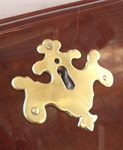

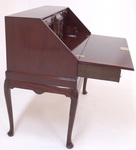
Georgian antiques are most sought after and span from 1714 – 1811. Dated
circa 1770 refers to the late Georgian period which was known as the “Golden
Age” of furniture. Famous designers such as Chippendale, Hepplewhite, and
Adam distinguished themselves during this period. The most important change
that occurred in the furniture in Georgian style was the replacement of
walnut by mahogany. The mahogany was generally sourced in Cuba and Honduras.
Cuban and Honduran mahogany is no longer available today and even Brazilian
mahogany is extremely rare.
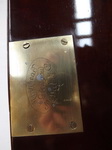
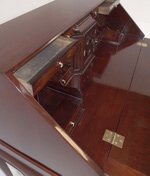
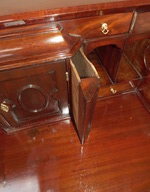
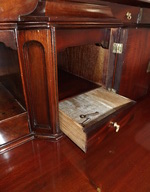
George III was the most attractive of the Hanoverian monarchs. He was a good
family man (there were 15 children) and devoted to his wife, Charlotte of
Mecklenburg-Strelitz, for whom he bought the Queen's House (later enlarged
to become Buckingham Palace). One of the most cultured of monarchs, George
started a new royal collection of books (65,000 of his books were later
given to the British Museum, as the nucleus of a national library) and
opened his library to scholars.
The major events of this period were the “Boston Tea Party” in 1773 and the
“United States Declaration of Independence” in 1776.
George III is widely remembered for
two things: losing the American colonies and going mad !
Flanagan's
History and marketing policy:
Flanagans Furniture Ltd is a 3rd generation
furniture business originating from Derry in Northern Ireland about 1946.
Flanagans’ market policy is built upon a somewhat quirky respect for their
customers’ taste and intelligence. Brian, who began the business in the mid
70’s, likes to raise eyebrows by asseverating that he puts the furniture
even before the customer! He believes that as far as antiques are concerned
both he, his craftsmen and his customers, are but trustees for future
generations. And as for new furniture it is not the trimmings that count so
much as the right furniture at the right price.
Brian's father, Jim, had always taught him to love the beautiful. So he came
up with a vision to start a business to produce modern designs utilizing old
craft skills.
But starting as he did with little more than an idea the age-old problems of
business soon made their presence felt. He struggled through the 70’s and
80’s to build and retain a team of cabinetmakers, polishers and
upholsterers. Manufacturing became well nigh impossible. Restoration work
continued and he steered the project firmly into the antiques market.
Their watchword for survival? A very wide range of product – both old and
new. We try never to say ‘No’. But the core answer is in fact that we do put
the furniture first. We have accepted furniture sold by us 30 years ago in
the 70’s and 80’s in part exchange. ‘Waste not want not.’ And we still allow
customers to try things out in their own homes. In other words we enter
typically upon a long-term ‘furniture conversation’ with folk. We become
their ‘furniture friends’. These conversations have to span both lean times
and good times. At all times it is about getting the furniture right.
And if you don’t credit this, just ask yourself: are you not at this very
moment engaged in one? Have you and we not started a furniture conversation?
We look forward to meeting you.